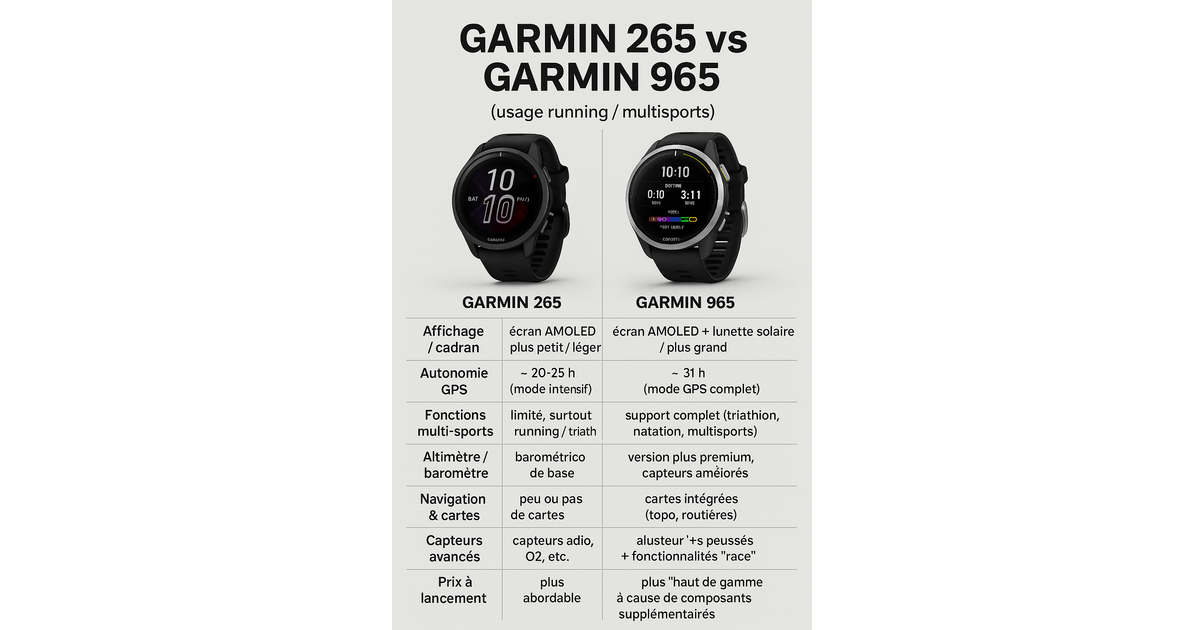Autonomy: Who holds the distance?
31 hours in GPS, it’s not flan. There Forerunner 965 crushes the 265 on this criterion. But should we really pay 150 € more for that?
In connected watch mode: the 965 takes off
23 days against 13 days (15 for the 265S). Frankly, going from two weeks to three weeks, it changes the situation. More recharges, less stress. For an average user, the 965 becomes almost a daily accessory, not something to connect every three days. (And for nomads, it’s concrete.)
In GPS mode: the impact on long outings
Here is gross figures ::
- Forerunner 965: Until 31 hours
- Forerunner 265 : Until 8 p.m.
- Forerunner 265S : Up to 24 hours
31 hours is heavy. For an average ultra-trail (say 24-30 hours), the 965 holds. The 265S is doing so for mid-long formats, but remains limited if you are slow or if you have breaks. The basic 265? 8 pm is just for marathonists. Suddenly, if you’re a follower of the 100km, You have no choice: the 965 is essential. But for an occasional runner, the 265 is enough. (Well, unless you forget your charger. There, it stings.)
Verdict: then, 265 or 965, which one to choose?
Running, swimming, pedaling: Garmin balances two drilling. But Which one sends the best time?
Profile 1: The runner on the road (5km, 10km, semi, marathon)
The Forerunner 265 is essential. AMOLED 1.3 “screen (416×416 pixels), Elevate V4 sensor (wrist power, vertical oscillations, body battery), autonomy 20h in GPS. (The 265S falls at 24 hours but weighs 39g!) No integrated cartography? No matter: For a bitumen runnerthey are frills. € 449, same metrics as the 965, zero superfluous gram. The 150 € difference? A jackpot for sneakers. Key detail: The barometric altimeter allows you to follow the elevations on hilly courses-useful for demanding half-marathons. And for Stryd followers: pairing is possible via the Connect IQ apps, but not in native mode. Not enough to penalize purists.
Profile 2: Triathlete and endurance athlete (Trail, Ultra, Ironman)
The 965 is worth its weight in gold. Screen 1.4 “(454×454 pixels), 20% brighter. Climbpro to anticipate the slopes, stamina in real time to manage the effort, topographic cards so as not to get lost. Autonomy: 31h in GPS.” Swimming/running profile “for Duathlons. The 150 € more? Insurance against the vagaries of training. LOAD RATIO COMPARES Training/Recovery load-a must for ultra-trails. Storage 32GB vs 8GB on the 265: Store 4x more music, practical for electronic marathons without phone. The 965 box titanium also resists shocks, an advantage on rugged trails.
In short: the summary for the pressed
- Garmin Forerunner 265 ::
- For: € 449, AMOLED screen, multi-band GPS, 39G (S version), wrist power, barometric altimeter
- Against : No mapping8 p.m. max in GPS, 8GB storage
- Garmin Forerunner 965 ::
- For: integral mapping, 31h GPS autonomy, Stamina/ClimePro/Load Ratio, 53g, 32GB
- Against: € 599, screen 1.4 “, no native Stryd
“The 265 is the racing watch almost perfect for the modern runner. The 965 is a multisport competition beast which justifies its price by functions that change the situation.”
If the profiles do not stick, other comparisons await. Watch for fencers? CrossFit? Trail Running? Garmin vs Suunto? There are some for All sports.
Garmin 265 or 965 ? Choice of priorities. 265: pure running (AMOLED screen, GPS, € 449). 965: Trail, Ultra, Triathlon (Integrated carto, 31h GPS, pro metrics, € 599). Difference of € 150. Titanium vs budget. Other tests await you.
